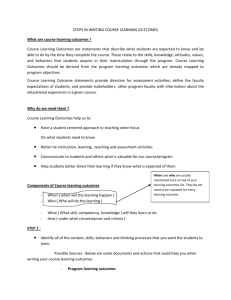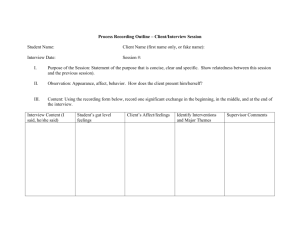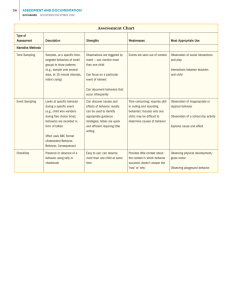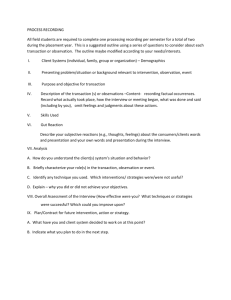Process Recording Template
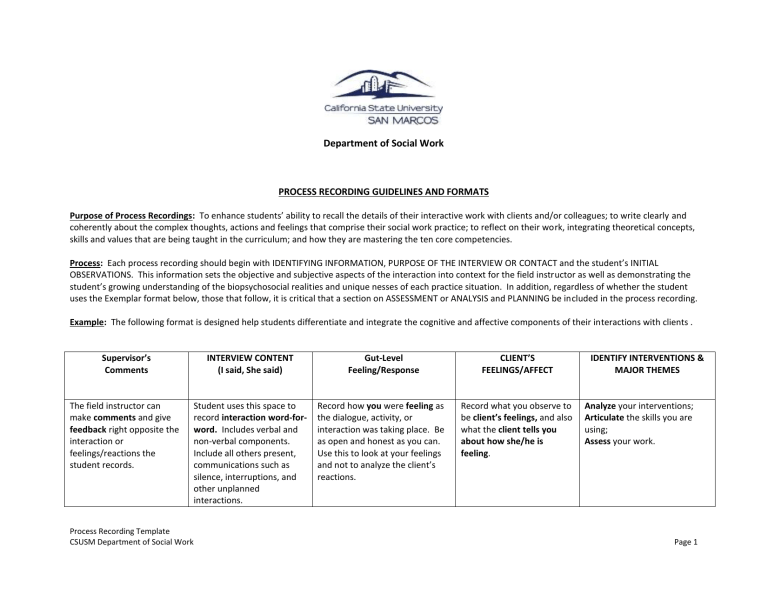
Department of Social Work
PROCESS RECORDING GUIDELINES AND FORMATS
Purpose of Process Recordings: To enhance students’ ability to recall the details of their interactive work with clients and/or colleagues; to write clearly and coherently about the complex thoughts, actions and feelings that comprise their social work practice; to reflect on their work, integrating theoretical concepts, skills and values that are being taught in the curriculum; and how they are mastering the ten core competencies.
Process: Each process recording should begin with IDENTIFYING INFORMATION, PURPOSE OF THE INTERVIEW OR CONTACT and the student’s INITIAL
OBSERVATIONS. This information sets the objective and subjective aspects of the interaction into context for the field instructor as well as demonstrating the student’s growing understanding of the biopsychosocial realities and unique nesses of each practice situation. In addition, regardless of whether the student uses the Exemplar format below, those that follow, it is critical that a section on ASSESSMENT or ANALYSIS and PLANNING be included in the process recording.
Example: The following format is designed help students differentiate and integrate the cognitive and affective components of their interactions with clients .
Supervisor’s
Comments
INTERVIEW CONTENT
(I said, She said)
Gut-Level
Feeling/Response
CLIENT’S
FEELINGS/AFFECT
IDENTIFY INTERVENTIONS &
MAJOR THEMES
The field instructor can make comments and give
feedback right opposite the interaction or feelings/reactions the student records.
Student uses this space to record interaction word-for-
word. Includes verbal and non-verbal components.
Include all others present, communications such as silence, interruptions, and other unplanned interactions.
Record how you were feeling as the dialogue, activity, or interaction was taking place. Be as open and honest as you can.
Use this to look at your feelings and not to analyze the client’s reactions.
Record what you observe to be client’s feelings, and also what the client tells you about how she/he is
feeling.
Analyze your interventions;
Articulate the skills you are using;
Assess your work.
Process Recording Template
CSUSM Department of Social Work Page 1
PROCESS RECORDING OUTLINE
FOR SOCIAL WORK PRACTICE WITH
INDIVIDUALS, COUPLES OR FAMILIES
A. Identifying Information
1.
Write a clear, concise statement about the client(s) and why they are seeing help.
2.
Include a brief statement about the age, sex, role, and other pertinent information
for each person present in the session.
3.
If relevant, include a brief statement about other people involved in the situation, which are not present, and how they influence the situation.
B. Purpose of the Session
1.
In a clear, concise statement, discuss the purpose of the session. a.
Indicate what the client or family considers the purpose of the session to be. b.
Indicate what you, as student social workers, consider the purpose of the session to be. c.
Indicate how these perceptions of purpose are similar or different. If different, briefly discuss the implications of this difference.
2.
Discuss the relationship between this session and the previous one(s).
C. Initial Observations of the Client(s)
1.
Describe briefly, in general terms, the physical and emotional climate at the beginning of the session.
2.
Describe you initial impressions of the attitudes and feelings of the client(s) at the beginning of the session.
3.
Describe the feelings and attitudes you brought to the session.
4.
Describe any significant changes in the client(s)’ appearance and surroundings that occurred since the previous session.
D. Content of the Session
1.
Describe how the session began.
2.
Describe the actual interaction between the client(s) and you, during the session. The content should be selective and focus on what is significant and pertinent.
3.
Specify pertinent information (content) communicated by the client(s) during the session.
4.
Describe how the client(s) and how you responded to this information (content).
5.
Describe the “feeling” content of the session, as it occurred, both on your part and the part of the client(s).
6.
Describe how the session ended.
Process Recording Template
CSUSM Department of Social Work Page 2
E. Assessment
1.
What is your current assessment of this client(s)? Include client(s)’ strength and weaknesses. a.
How is your current assessment the same as or different from your original assessment? b.
Indicate the theory or other knowledge, learned in your other courses, that helps you understand the process and content of this session, e.g., what knowledge of human behavior or the human condition applies in this practice situation?
F. Plan for the Next Session
1.
Write a brief statement of the plan for the next session. a.
Explain how you and the client(s) engaged n a mutual process to formulate the plan. b.
Explain how the plan relates to the problem for which the client(s) sought help.
2.
If relevant, specify what the client(s) are to do between the end of the current interview or session and the next time you meet.
G. Analysis of the Student Social Worker’s Practice
1.
Discuss your use of social work practice knowledge and skill during the interview or family session. a.
What specific social work skills and/or techniques, learned in your practice courses, did you use during the session? b.
What specific social work sills and/or techniques, learned in you practice courses, could you have used during the session? c.
What were the strengths and weaknesses in your practice during the session?
2.
Was the purpose of the session accomplished?
After completing the table, reflect upon the session and respond follow-up questions and use of EPAS competency practice behavior.
NOTE: We request that full names not be used in recordings, only initials, in order to protect confidentiality. Student recordings do not become the property of the student. They should be destroyed at the end of the year or retained by the agency, as the material is confidential
Process Recording Template
CSUSM Department of Social Work Page 3
PROCESS RECORDING OUTLLINE FOR SOCIAL WORK PRACTICE WITH GROUPS
A. Information about the Group
Group Name or Type
Meeting Number Date
Group Members present:
B. Purpose of the Group or Meeting
1.
Write a brief statement on the overall purpose of the group a.
This statement is included only in the first process recording, or if there is an agreed upon change in the group’s overall purpose.
2.
Write a concise statement about the goals of the meeting of the group being recorded. a.
How were these goals perceived by the group? b.
How did you perceive these goals? c.
What are the similarities or differences between the group’s perception of these goals and yours?
C. Group Process at the Meeting
1.
Initial Observations a.
Describe briefly, in general terms, the physical and emotional climate at the beginning of the group meeting. b.
Describe briefly your initial impressions of the attitudes and feelings of the group members at the beginning of the meeting. c.
Describe any significant changes in the appearance or feelings or attitudes f the group members since the last meeting.
2.
Group Member Interaction (Group Process) a.
Describe what went on within the group during its meeting. For example:
(1) Describe the means of interaction, e.g., program activity, discussion, debate, tasks, etc.
(2) Describe the feeling reactions of the members to this interaction.
(3) Describe your feeling reactions to this interaction. b.
Describe the effectiveness, vitality, and responsibility of the group’s members during the interaction. c.
Describe your role in the group’s interaction. d.
Describe the ways the group moved toward attainment of its goals e.
Describe how the group’s members dealt with obstacles to attainment of the meeting’s goals.
D. Analysis of the Group Meeting
1.
Describe your understanding of the nature of the interaction of the group members, including you, at this group meeting.
2.
Indicate the theoretical or other knowledge, learned in you other courses, that helps you to understand the process and content of this group meeting.
Process Recording Template
CSUSM Department of Social Work Page 4
3.
On the basis of your analysis, what is your current assessment of: a.
The stage of the group’s development; b.
The commitment of the group members to the group’s purpose; c.
The climate and tone of the group; d.
If relevant, discuss specific roles played by individual group members and how they impact the group process.
E. Plan for the Group’s Next Meeting
1.
Write a brief statement of the plan for the next meeting of the group. a.
Explain how the members of the group, including you, arrived at this plan. b.
Explain how the plan relates to the purpose of the group.
2.
Describe what you and the other group members are to do prior to, and in preparation for, the next group meeting.
F. Analysis of the Student Social Worker’s Practice
1.
Discuss your use of social work practice knowledge and skills during the group meeting. a.
What specific social work skills and/or techniques, learned in your practice courses, did you use during the group meeting? b.
What were the strengths and weaknesses in your practice during the group meeting?
After completing the table, reflect upon the session and respond follow-up questions and use of EPAS competency practice behavior.
NOTE: We request that full names not be used in recordings, only initials, in order to protect confidentiality. Student recordings do not become the property of the student. They should be destroyed at the end of the year or retained by the agency, as the material is confidential
Process Recording Template
CSUSM Department of Social Work Page 5
III.
II.
Student Name:
Interview Date:
I. IDENTIFYING CLT INFORMATION:
OBSERVATION:
PURPOSE OF THE SESSION:
Process Recording Template
CSUSM Department of Social Work
Department of Social Work
PROCESS RECORDING FORM
Client Name:
Session #:
Agency:
Page 6
SUPERVISORY
COMMENTS
Process Recording Template
CSUSM Department of Social Work
INTERVIEW CONTENT
(I said, She said)
STUDENT’S GUT
LEVEL FEELINGS
.
CLIENT’S
FEELINGS/AFFECT
IDENTIFY INTERVENTIONS &
MAJOR THEMES
Page 7
Process Recording Template
CSUSM Department of Social Work Page 8
IV. IMPRESSIONS/ASSESSMENT: 1) What did you observe throughout the session – 1) behavior and affect; 2) was the behavior/affect appropriate, explain; 3) how does this behavior/affect fit with what you know about the client’s past behavior/affect; and 4) identify the major themes/issues that emerged.
V. USE OF PROFESSIONAL SELF: Choose two significant interventions you made: 1) identify/describe; 2) what was your impression of your effectiveness; and 3) what would you change.
VI. PLANS: (Brief statement of your plans for the next session, long range goals, short range goals that are relevant for this client.)
VII. ISSUES, QUESTIONS OR PROBLEMS: (To explore in supervisory sessions.) Areas to explore in your supervisory conference: include issues of diversity, value dilemmas, counter-transference etc.
Process Recording Template
CSUSM Department of Social Work Page 9
1.
POST INTERACTION ANALYSIS & INTEGRATION OF CLASSROOM LEARNING WITH FIELD:
Note: Sections A, B, and C may not all be applicable for each recording. Please choose the one that links best with the interaction that you had with the client you are presenting in this recording.
A.
Identify a theory that you learned in the Human Behavior & Theory courses. Explain how this theory helps you to understand the client/client’s situation better. Specifically reflect on how this theory helps guide your practice.
B.
Identify a policy that you learned in your Policy Practice courses. Explain how your client/client system faces challenges in working through certain policies (agency policies, federal policies, etc.) and how you think they can be addressed.
C.
Based on the knowledge of Research (through your research courses), can you identify the possible research questions that could be developed on the issue.
Process Recording Template
CSUSM Department of Social Work Page 10
2. IDENTIFYING SPECIFIC PRACTICE BEHAVIORS FROM THE EPAS CORE COMPETENCIES: Explain how you implemented these behaviors with your client. (Use your learning from your Practice courses to reflect on this aspect, review them over a period of time and discuss in supervision).
Core Competency 2.1.1: Identify as a professional social worker and conduct one-self accordingly:
(Select one or more Practice Behaviors from the list below for the Core Competency).
• advocate for client access to the services of social work;
• practice personal reflection and self-correction to assure continual professional development;
• attend to professional roles and boundaries;
• demonstrate professional demeanor in behavior, appearance, and communication;
• use supervision and consultation.
Explain how you used one or more practice behaviors.
Core Competency 2.1.2:
Apply Social Work Ethical principles to guide ethical practice:
(Select one or more Practice Behaviors from the list below for the Core Competency).
• recognize and manage personal values in a way that allows professional values to guide practice;
• make ethical decisions by applying standards of the NASW Code of Ethics
• tolerate ambiguity in resolving ethical conflicts; and
• apply strategies of ethical reasoning to arrive at principled decisions.
Explain how you used one or more practice behaviors.
Process Recording Template
CSUSM Department of Social Work Page 11
Core Competency 2.1.3: Apply Critical thinking to inform and communicate professional judgment:
(Select one or more Practice Behaviors from the list below for the Core Competency).
• distinguish, appraise, and integrate multiple sources of knowledge, including research-based knowledge, and practice wisdom;
• analyze models of assessment, prevention, intervention, and evaluation;
• demonstrate effective oral and written communication in working with individuals, families, groups, organizations, communities, and colleagues.
Explain how you used one or more practice behaviors.
Core Competency 2.1.4: Engage diversity and difference in practice:
(Select one or more Practice Behaviors from the list below for the Core Competency).
• recognize the extent to which a culture’s structures and values may oppress, marginalize, alienate, or create or enhance privilege and power;
• gain sufficient self-awareness to eliminate the influence of personal biases and values in working with diverse groups;
• recognize and communicate their understanding of the importance of difference in shaping life experiences; and
• view themselves as learners and engage those with whom they work as informants.
Explain how you used one or more practice behaviors.
Process Recording Template
CSUSM Department of Social Work Page 12
Core Competency 2.1.5: Advance human rights and social and economic justice:
(Select one or more Practice Behaviors from the list below for the Core Competency).
• understand the forms and mechanisms of oppression and discrimination;
• advocate for human rights and social and economic justice;
• engage in practices that advance social and economic justice.
Explain how you used one or more practice behaviors.
Core Competency 2.1.6: Engage in research-informed practice and practice-informed research:
(Select one or more Practice Behaviors from the list below for the Core Competency).
• use practice experience to inform scientific inquiry;
• use research evidence to inform practice.
Explain how you used one or more practice behaviors.
Process Recording Template
CSUSM Department of Social Work Page 13
Core Competency 2.1.7: Apply knowledge of human behavior and the social environment:
(Select one or more Practice Behavior from the list below for the Core Competency).
• utilize conceptual frameworks to guide the processes of assessment, intervention, and evaluation;
• critique and apply knowledge to understand person and environment.
Explain how you used one or more practice behaviors.
Core Competency 2.1.8: Engage in policy practice to advance social and economic well-being and to deliver effective social work services:
(Select one or more Practice Behaviors from the list below for the Core Competency).
• analyze, formulate, and advocate for policies that advance social well-being;
• collaborate with colleagues and clients for effective policy action
Explain how you used one or more practice behaviors.
Process Recording Template
CSUSM Department of Social Work Page 14
Core Competency 2.1.9 : Respond to contexts that shape practice:
(Select one or more Practice Behaviors from the list below for the Core Competency).
• Continuously discover, appraise, and attend to changing locales, populations, scientific and technological developments, and emerging societal trends to provide relevant services with emphasis on rural and small communities;
• Provide leadership in promoting sustainable changes in service delivery and practice to improve the quality of social services.
Explain how you used one or more practice behaviors.
(Select one or more Practice Behavior from the list below for the Core Competency).Engagement:
• substantively and affectively prepare for action with individuals, families, groups, organizations, and communities;
• use empathy and other interpersonal skills;
• develop a mutually agreed-on focus of work and desired outcomes.
Assessment Skills:
• collect, organize, and interpret client data;
• assess client strengths and limitations;
• develop mutually agreed-on intervention goals and objectives;
• select appropriate intervention strategies.
Intervention Skills:
• initiate actions to achieve organizational goals;
• implement prevention interventions that enhance client capacities;
• help clients resolve problems;
• negotiate, mediate, and advocate for clients;
• facilitate transitions and endings.
Evaluation Skills:
• critically analyze, monitor, and evaluate interventions
Explain how you used one or more practice behaviors.
Process Recording Template
CSUSM Department of Social Work Page 15
